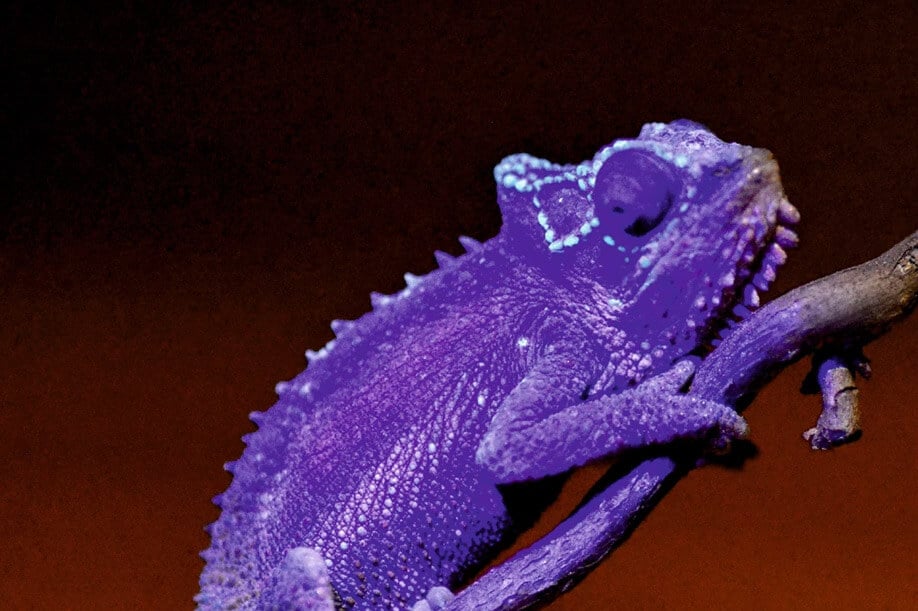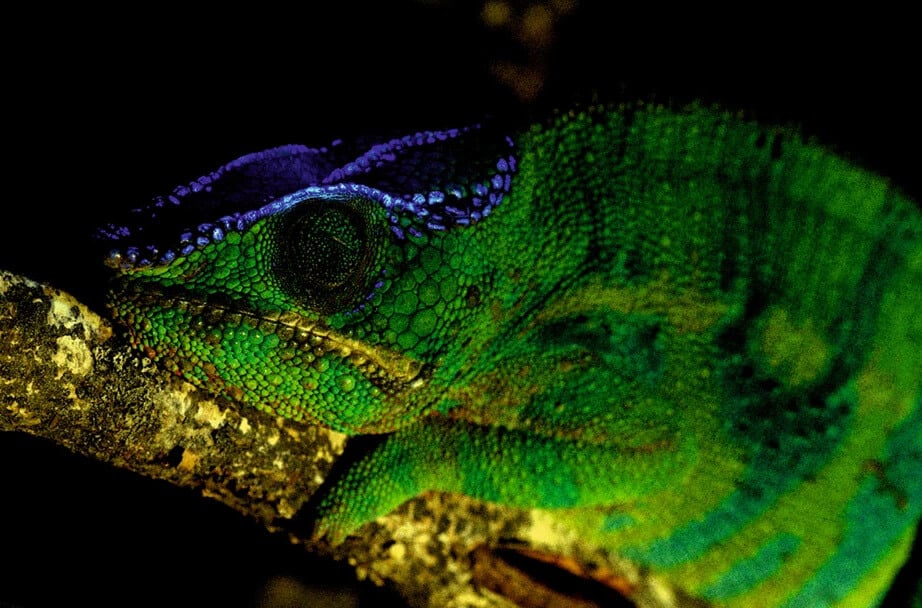The decoration of chameleons is not limited to their outer part - and the bones of many of them glow through their skin under ultraviolet light. This is how the chameleons never stop surprising with original costumes that can be an inspiration for our most colorful holiday
Purim is the holiday where everything is possible; Through make-up, clothing and accessories we can become different and strange creatures, and go beyond the limits of reality and humanity. One example of this is one of the costumes that are common during the holiday - the "skeleton" costume that includes a tight black garment on which the bones of the body are printed in bright white. This costume, which looks like an X-ray of the wearer, creates the illusion that the bones are visible through the human body. But in nature, there are those who do not need this illusion: chameleons, whose bones glow through their skin under ultraviolet light all year round.
Many animals dressing up in nature, mainly for camouflage and survival purposes. Even before the discovery of the glowing bones, the chameleon was seen as the champion of disguise, and as we know, she got a reputation as someone who can change her color for camouflage purposes and blend in with any background she is in.

The more-hidden decorating abilities of this colorful animal were discovered whenResearchers from Germany They illuminated many species of chameleons with ultraviolet (UV) light, and discovered that small bones in the chameleon's skull region glowed through their skin - as if they had been painted with body makeup found at the full moon parties in Thailand. This phenomenon is called fluorescence: emission of light from a material exposed to visible (like light) or invisible (like ultraviolet light) radiation, when the wavelength of the emitted light is longer than the wavelength of the projected light - which allows us to see with our eyes what glows under ultraviolet light At parties, even we are unable to see the ultraviolet light itself.
Skin on cellophane paper standard
In fact, all the bones glow under ultraviolet light - even ours, and the reason for this is the collagen protein and the calcium-phosphorus mineral that make up the the bone. These two substances - especially the collagen - emit light. But unlike chameleons, our skin and other tissues do not allow the reflection of fluorescent light from the bones (or the penetration of ultraviolet light through them in the first place).
The part of the skeleton of the chameleons that glows is mainly small round bones that stick out from their skulls (Tubercles). The layer of skin that covers them is very thin, which allows the ultraviolet light to penetrate through it to the bones, and the fluorescent light emitted by the bones to shine through it out of the body. Also, this layer of skin is used as a filter that filters some of the fluorescent light emitted from the bones, causing it to shine in a bluer shade - like cellophane paper or colorful filters that are put on white bulbs to get colored light. Beyond that, the "costumes" of the chameleons of the various species include complex patterns of dots and stripes, on the head and sometimes also on the rest of the body.
This decoration implies that other chameleons can see these bones - and in fact, it is a way to communicate with other individuals. The decorations under the skin are not limited to chameleons only: after the discovery, further research found that the back bones of toads of the species Brachycephalus ephippium (known in English as "pumpkin toads") Glowing through their skin under ultraviolet light. In this case too, the researchers speculate that the feature is used by the animals to transmit messages between them.
It should be noted that the general phenomenon of animals glowing under ultraviolet light is not new to science. Fluorescence is mostly common in many marine creatures, such as Coral, fish, jellyfish and more, and like them also in a few terrestrial species and amphibians such as frog The trees the dotted one the South-American (Hypsiboas punctatus) all her skin glows under ultraviolet light. The difference is that with all these creatures, the outer tissues of their bodies are the ones that glow - therefore, the bones that shine through the skin for communication are a unique and exciting phenomenon.
Chameleon costumes made in Israel
A species of chameleon also lives in Israel: the Mediterranean chameleon. The bones of this chameleon do not glow through their skin under ultraviolet light - but they also have impressive "costumes".

"The most famous feature of chameleons is changing the color patterns of their body depending on the color of the environment, but the Mediterranean chameleon usually does not change its skin tone according to the background it is on," says Dr. Tami Kern-Rotem from the Science Division of the Nature and Parks Authority, who researches For over 20 years the behavior of the Mediterranean chameleon in its natural environment within the framework of Tel Aviv University. "within study our We have seen in some cases color model changes depending on the environment - when we put a chameleon on a brown background and it changed its color model to this shade. But if there was an opportunity to mate - the chameleon changed its color model again, so that in fact intersexual communication is a more influential factor in the color changes in these chameleons."
According to Keren-Rotem, the color of Mediterranean chameleons does change throughout their lives, depending on the habitat where they live. "And in the first weeks of their lives, chameleons live close to ground level, while in the forest they are mainly found on dry brown and yellow grass," she says. "All chameleons hatch brown, so their body color is similar to the color of the environment." According to her, when the chameleons grow, these grasses can no longer support their body weight. Therefore, they rise in height, to bushes and trees, and gradually change their color to green - that is, they adapt themselves to the tone of the new environment.
To shine like the chameleons on Purim
It should be noted that the various Mediterranean chameleons do not wear a uniform outfit: Keren-Rotem says that she discovered in her research that chameleons have 12 color patterns, with each pattern having a different meaning. The chameleons use the various models to report to other chameleons they meet about their intentions, their sex, their reproductive status and more. "Each model conveys a different message," explains Keren-Rotem. "Such a message can be whether a female is interested in mating or not, or whether it is a dominant male guarding the female - or alternatively, a small male with a stealth reproductive strategy that waits for the departure of a dominant male to mate. The chameleons "change" this outfit quickly, so as not to be discovered by predators - when a male meets a female during the breeding season, for example, he may change his color pattern - and after a few minutes he will change it again to a camouflage pattern.

Moreover, each chameleon has two fragmented white stripes on the sides of its body (different between its two sides), and a harness horn showed which differ from individual to individual. Like the different color patterns, these stripes are also used as a means of communication between the individuals.
There is no doubt that chameleons can teach us a thing or two about using color - but also about smart use of existing resources. Purim is a lovely holiday, and at the same time polluting - ripe Costumes fabrics Cheap which are intended for a small number of wearables, as well as package deliveries with a lot of single-use plastic. So maybe this year we can take a little inspiration from the special reptiles, and not buy another costume that we will wear and throw away - but shine on Purim using the objects and accessories we already have.
More of the topic in Hayadan:
